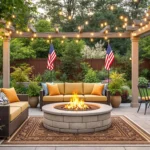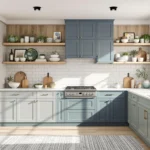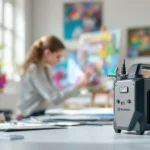Ready to transform your kitchen from basic to breathtaking? We’ve been exploring the rising trend of moody kitchens that’s taking interior design by storm. These dramatic, atmospheric spaces offer a refreshing alternative to the all-white kitchens that have dominated for years.
Dark cabinetry, rich color palettes, and ambient lighting aren’t just stylish choices—they create kitchens with personality and depth. Whether you’re planning a full renovation or looking for simple updates, incorporating moody elements can instantly elevate your space. We’ll show you how to balance darkness with light, select the perfect statement pieces, and create a kitchen that feels both sophisticated and welcoming.
Understanding the Appeal of Moody Kitchen Designs
Moody kitchens have captured the imagination of homeowners and designers alike for several compelling reasons. The shift away from bright, all-white spaces toward darker, more atmospheric kitchens represents more than just a passing trend—it’s a movement toward creating spaces with depth and character.
Dark cabinetry serves as the foundation for these designs, offering a sophisticated backdrop that immediately transforms the energy of the room. Rich color palettes featuring deep blues, forest greens, charcoal grays, and even blacks create a sense of luxury and intimacy that lighter kitchens simply cannot achieve.
The contrast between dark elements and carefully placed lighting creates a dramatic interplay of shadows and illumination. Ambient lighting answers become even more impactful in moody kitchens, highlighting architectural details and creating pools of warmth that draw people in.
Textural elements play a crucial role in moody kitchen designs, with materials like honed stone, brushed metals, and grained woods adding dimensionality that prevents dark spaces from feeling flat or one-dimensional. These tactile surfaces invite touch and create visual interest that changes throughout the day as natural light shifts.
Moody kitchens excel at creating emotional responses, evoking feelings of comfort, sophistication, and warmth that sterile white kitchens often lack. Many homeowners find these spaces feel more personal and reflective of their individual style than conventional bright kitchens.
The versatility of moody designs allows them to complement various architectural styles, from Victorian to ultra-modern, making them adaptable to homes of different eras and characters. Their timeless quality stems from drawing inspiration from historic precedents while incorporating contemporary elements that prevent the look from feeling dated.
Perhaps most importantly, these darker kitchen designs offer a welcome respite from the visual noise of daily life, creating a cocoon-like environment that feels both protective and nurturing. The psychological impact of these spaces shouldn’t be underestimated—they can transform ordinary cooking routines into more meaningful, atmospheric experiences.
10 Dark Color Palettes for a Sophisticated Kitchen Atmosphere
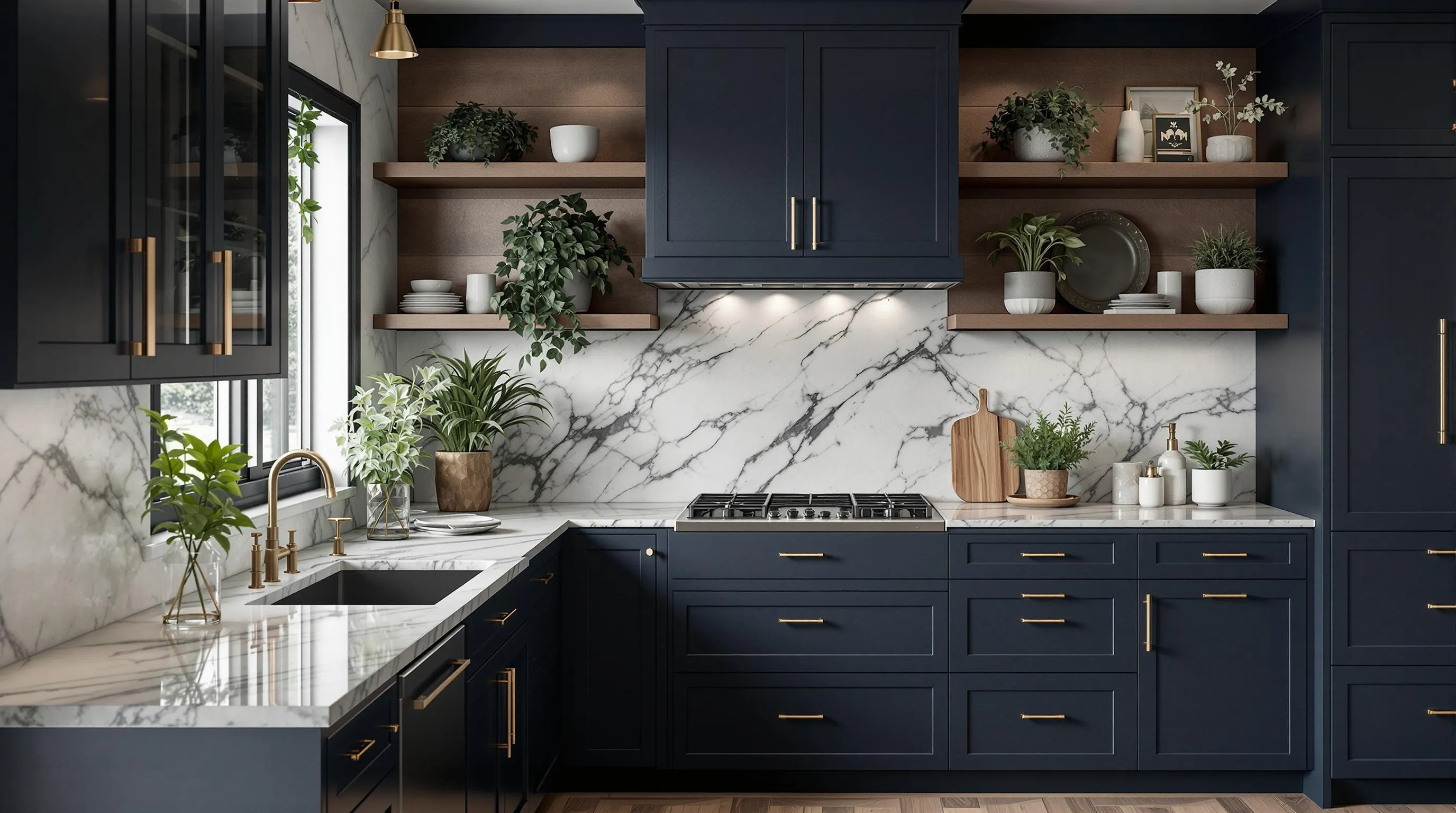
Creating a moody kitchen requires the right color combination to establish that perfect balance of sophistication and warmth. Here are ten dark color palettes that will transform your kitchen into an elegant, atmospheric space.
Deep Navy and Brass Combinations
Deep navy cabinetry creates an immediate sense of sophistication when paired with warm brass fixtures. This classic combination offers a rich backdrop that feels both timeless and contemporary. Brass hardware, faucets, and lighting fixtures provide necessary warmth against the cool navy tones, preventing the space from feeling cold or overwhelming. The metallic elements catch and reflect light throughout the space, adding dimension and visual interest to your moody kitchen design.
Charcoal Gray with Natural Wood Elements
Charcoal gray serves as an excellent foundation for a moody kitchen while natural wood elements introduce organic warmth. This balanced aesthetic works particularly well with oak or walnut accents, which soften the intensity of the dark gray. Consider incorporating wood through open shelving, butcher block sections on countertops, or exposed ceiling beams. The textural contrast between smooth painted surfaces and natural wood grain creates depth while maintaining an inviting atmosphere that doesn’t feel too severe or industrial.
Black-on-Black with Textural Variations
Black kitchens deliver maximum drama when designed with thoughtful textural variations. Combining different black finishes—matte cabinets, glossy backsplashes, and rustic black metal fixtures—creates a sophisticated layered effect. Texture becomes the star in this monochromatic approach, preventing the space from appearing flat or one-dimensional. Consider incorporating black stone with visible veining, leather-finish granite, or patterned black tiles to add further depth to this bold palette choice.
Emerald Green and Gold Accents
Emerald green cabinetry paired with gold accents creates a luxurious color combination that exudes opulence. This rich, jewel-toned palette brings a sense of drama while remaining surprisingly versatile in various lighting conditions. Gold hardware, faucets, and light fixtures complement the deep green tones perfectly, adding warmth and sophistication. The emerald provides a beautiful alternative to black or navy while still delivering that coveted moody atmosphere.
Dark Gray and Marble
Dark gray cabinets complemented by marble countertops create a high-contrast, refined aesthetic. This pairing works exceptionally well in contemporary kitchen designs where clean lines and sophisticated materials take center stage. White marble with distinctive veining adds movement and visual interest against the solid gray backdrop. This combination balances darkness with light effectively, ensuring your moody kitchen remains bright enough for practical use while maintaining its dramatic appeal.
Dark Wood and Metallic Accents
Dark wood cabinetry gains depth and character when enhanced with strategic metallic accents. Copper, silver, or bronze elements introduce reflective qualities that brighten the overall mood while preserving the rich, warm foundation. This traditional-meets-modern approach works well in transitional homes, offering timeless appeal with contemporary touches. The natural grain patterns in dark walnut, mahogany, or ebonized oak add inherent texture that metallic elements further enhance.
Black and White High Contrast
Black walls or cabinets juxtaposed against crisp white countertops create a dramatically contrasting kitchen with timeless appeal. This high-impact pairing offers maximum visual drama while remaining surprisingly practical for everyday use. The white elements help reflect light throughout the space, preventing the black features from feeling too heavy or overwhelming. Consider black cabinetry with white marble countertops or black walls with white upper cabinets for a balanced interpretation of this classic contrast.
Charcoal Gray and Reclaimed Wood
Charcoal gray cabinetry complemented by reclaimed wood elements delivers a perfect blend of contemporary sophistication and rustic warmth. This combination feels both modern and lived-in, creating a cozy atmosphere with substantial character. Weathered wood beams, open shelving, or a reclaimed wood island bring textural interest and historical depth to an otherwise sleek design. This palette works beautifully in farmhouse-inspired spaces looking to incorporate moodier elements.
Navy Blue and Brass Hardware
Navy blue cabinets adorned with brass hardware create a classic, sophisticated kitchen palette with nautical undertones. This timeless combination feels both traditional and fresh, offering versatility across different design styles. Brass pulls, knobs, and fixtures pop beautifully against the deep blue background, adding necessary warmth and metallic reflection. Navy provides a more approachable alternative to black while still delivering substantial depth and richness to your kitchen design.
Dark Stone and Soft Lighting
Dark stone countertops paired with strategic soft lighting create a cozy, intimate kitchen atmosphere with natural elegance. Materials like soapstone, dark granite, or black marble set a dramatic foundation that warm lighting then softens and enhances. Under-cabinet lighting, pendant fixtures with warm bulbs, and even candles can transform these dark surfaces from simply moody to invitingly atmospheric. This combination celebrates the natural beauty of stone while creating a welcoming environment for gathering and dining.
Lighting Solutions That Enhance a Moody Kitchen Aesthetic
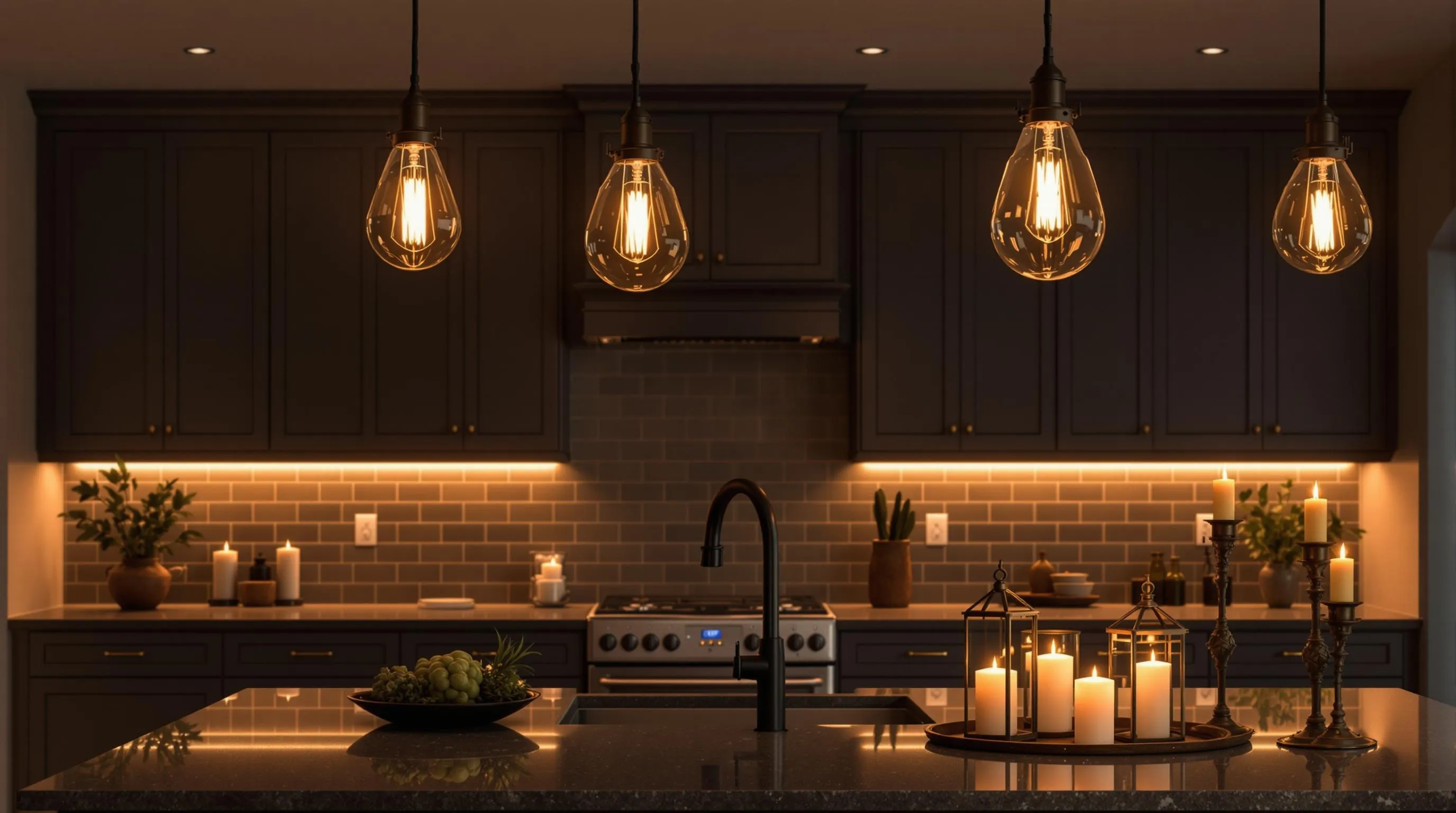
Statement Pendant Lighting Options
Industrial-style pendants featuring Edison bulbs or matte-black finishes serve as striking focal points while providing warm, diffused illumination throughout your kitchen space. Oversized pendant designs in brass, black, or aged bronze create dramatic contrast against dark cabinetry, drawing the eye upward and adding architectural interest. Dimmable fixtures offer versatility for adjusting the ambiance based on time of day or activity, allowing you to transition from bright task lighting to intimate evening settings. These statement pieces don’t just illuminate your space—they anchor your design and reinforce the moody aesthetic through their substantial presence and carefully selected finishes.
Under-Cabinet Lighting for Dramatic Effect
LED strip lights or puck lights installed beneath cabinetry illuminate countertops with precision while maintaining the overall moody atmosphere of your kitchen. Warm white lighting (2700K–3000K) enhances the richness of wood tones and dark backsplashes, creating a subtle glow that highlights textures in stone countertops or matte cabinet finishes. This targeted illumination ensures functional workspace lighting without flooding the room with overhead brightness that would diminish the intentional moodiness. Pairing under-cabinet lighting with directional wall sconces creates a layered lighting approach that balances practicality with atmosphere, ensuring your kitchen remains usable while preserving its dramatic character.
Candles and Ambient Light Sources
Candles placed in hurricane holders or wall-mounted lanterns introduce flickering, ever-changing light that adds depth and movement to moody kitchen environments. These soft light sources complement recessed ceiling fixtures that provide general illumination, working together to ensure dark corners feel intentionally intimate rather than neglected or shadowy. Battery-operated candles and LED tea lights nested inside glass enclosures offer flame-free alternatives that deliver similar ambiance without safety concerns. The interplay between different light sources—task lighting for functionality, pendant lighting for statement, and ambient lighting for atmosphere—creates a sophisticated lighting industry that enhances rather than fights against your kitchen’s moody aesthetic.
Incorporating Rich Materials in Your Moody Kitchen
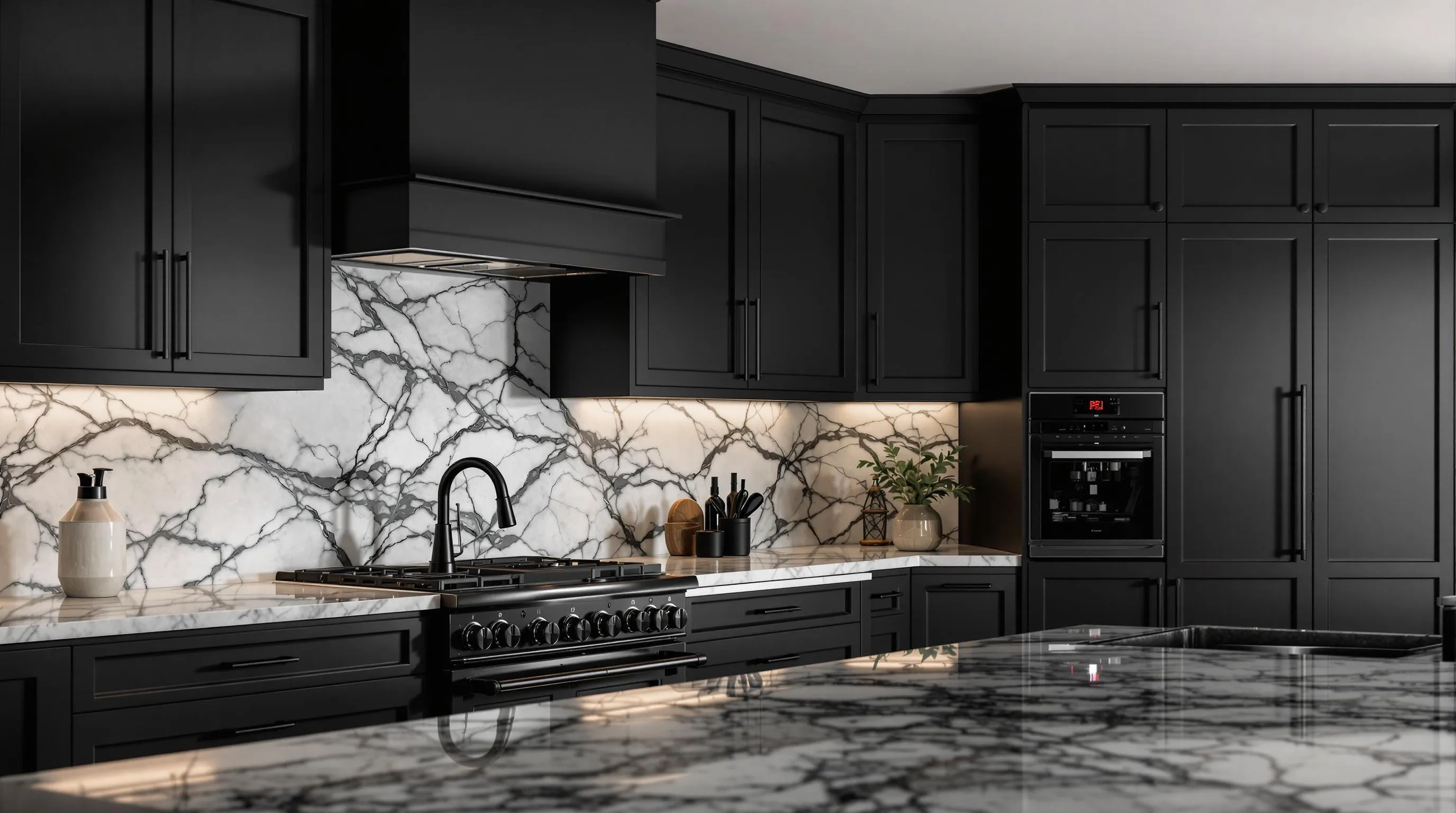
The foundation of any captivating moody kitchen lies in its materials. Rich, textural elements create depth and sophistication while establishing a cozy atmosphere that invites both conversation and culinary creativity.
Matte Black Fixtures and Hardware
Matte black fixtures and hardware serve as the perfect anchoring elements in a moody kitchen design. These sophisticated components absorb light rather than reflect it, reducing glare and improving the overall atmospheric quality of the space. Hardware pieces like cabinet pulls, faucets, and lighting fixtures in matte black finish create a cohesive look throughout the kitchen while providing striking contrast against darker cabinetry or lighter stone surfaces. Selecting these light-absorbing elements helps maintain the intended moody ambiance without introducing unwanted shine that might disrupt the kitchen’s carefully cultivated atmosphere.
Veined Marble and Dark Stone Countertops
Veined marble and dark stone countertops introduce natural luxury and visual intrigue to moody kitchens. These materials offer nuanced patterns that effectively break up solid dark colors, preventing the space from feeling overly monotonous or heavy. Natural stone with dramatic veining creates movement across surfaces while maintaining the sophisticated palette essential to moody design. Darker stone options like black granite or deep-toned quartzite provide durability alongside elegance, ensuring your countertops remain both functional and visually stunning. The subtle variations in these materials add dimension to the kitchen, keeping the space comfortable and inviting even though its darker palette.
Textured Backsplash Options
Textured backsplashes add essential depth and character to moody kitchen designs through various material applications. High-gloss tile options create ever-changing contrast against matte elements, reflecting available light to brighten the space strategically without compromising the moody aesthetic. Rustic stone backsplashes introduce natural texture and earthy appeal, connecting the kitchen to organic elements while maintaining the sophisticated atmosphere. Glass tiles offer another dimension by subtly reflecting light throughout the space, improving the kitchen’s ambiance while providing a sleek, contemporary surface. Mixing textures in your backsplash selection prevents the kitchen from feeling flat, creating visual interest that draws the eye and adds complexity to the overall design.
Creating Contrast in Dark Kitchen Spaces
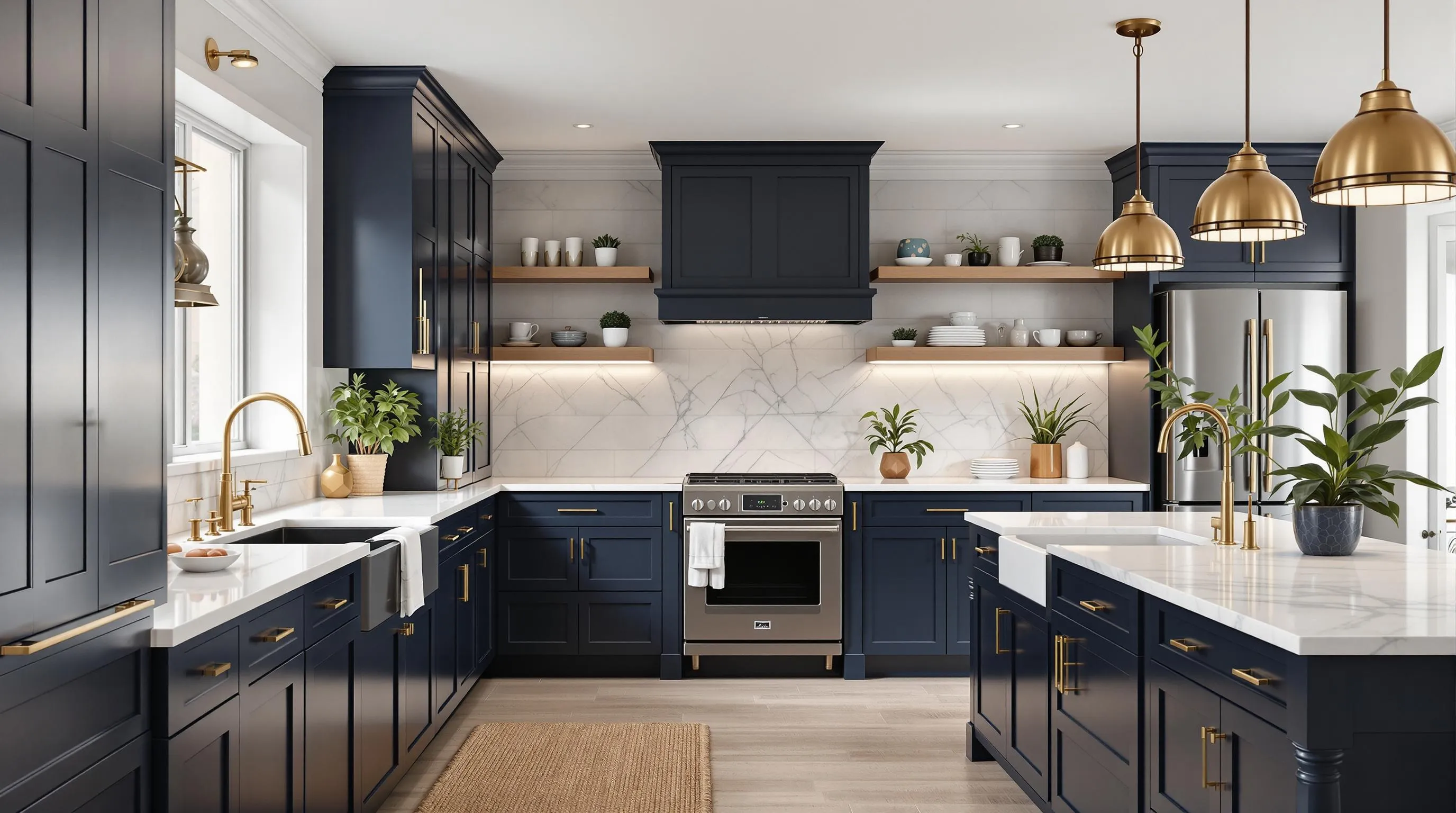
Creating stunning contrast in moody kitchens requires intentional pairing of dark elements with lighter tones. Achieving this balance prevents spaces from feeling too heavy while maintaining the dramatic atmosphere that makes dark kitchens so appealing.
White Accents in Moody Kitchens
White serves as an essential grounding neutral in moody kitchen palettes, creating breathing space within darker designs. Incorporating white marble or quartz countertops instantly brightens work surfaces while providing a practical area for food preparation that stands out against dark cabinetry. Backsplashes featuring white subway tiles or Moroccan-style patterns reflect available light throughout the space, improving the kitchen’s overall brightness without compromising its moody character. Light-toned ceilings play a crucial role in preventing enclosed feelings in low-light kitchens, opening up the visual space above and creating a sense of height. We’ve found that these white elements don’t diminish the impact of dark cabinets in navy, black, or deep green—instead, they enhance their richness through deliberate contrast.
Metallic Elements That Pop Against Dark Backgrounds
Metallic finishes introduce warmth and dimension, becoming even more impactful against dark kitchen backdrops. Brass and gold fixtures, cabinet hardware, and pendant lights add luxurious contrast when paired with black or navy cabinetry, creating focal points that draw the eye. Copper elements like vintage cookware or statement sinks bring rustic charm to green or gray color schemes, adding a warm, lived-in quality to moody spaces. Chrome and stainless steel appliances provide sleek, reflective surfaces that bounce light around the room while maintaining a contemporary edge. Mixing different finishes creates additional depth—pairing matte cabinets with glossy tiles or textured metals adds sophisticated layering. Designers recommend incorporating layered lighting schemes with these metallic elements, using under-cabinet LEDs alongside statement pendants to maintain both functionality and atmosphere. Adding natural elements like houseplants and woven rugs helps soften the overall aesthetic, creating balance between hard metallic surfaces and the rich tones of a moody kitchen.
Plants and Natural Elements for Moody Kitchen Designs
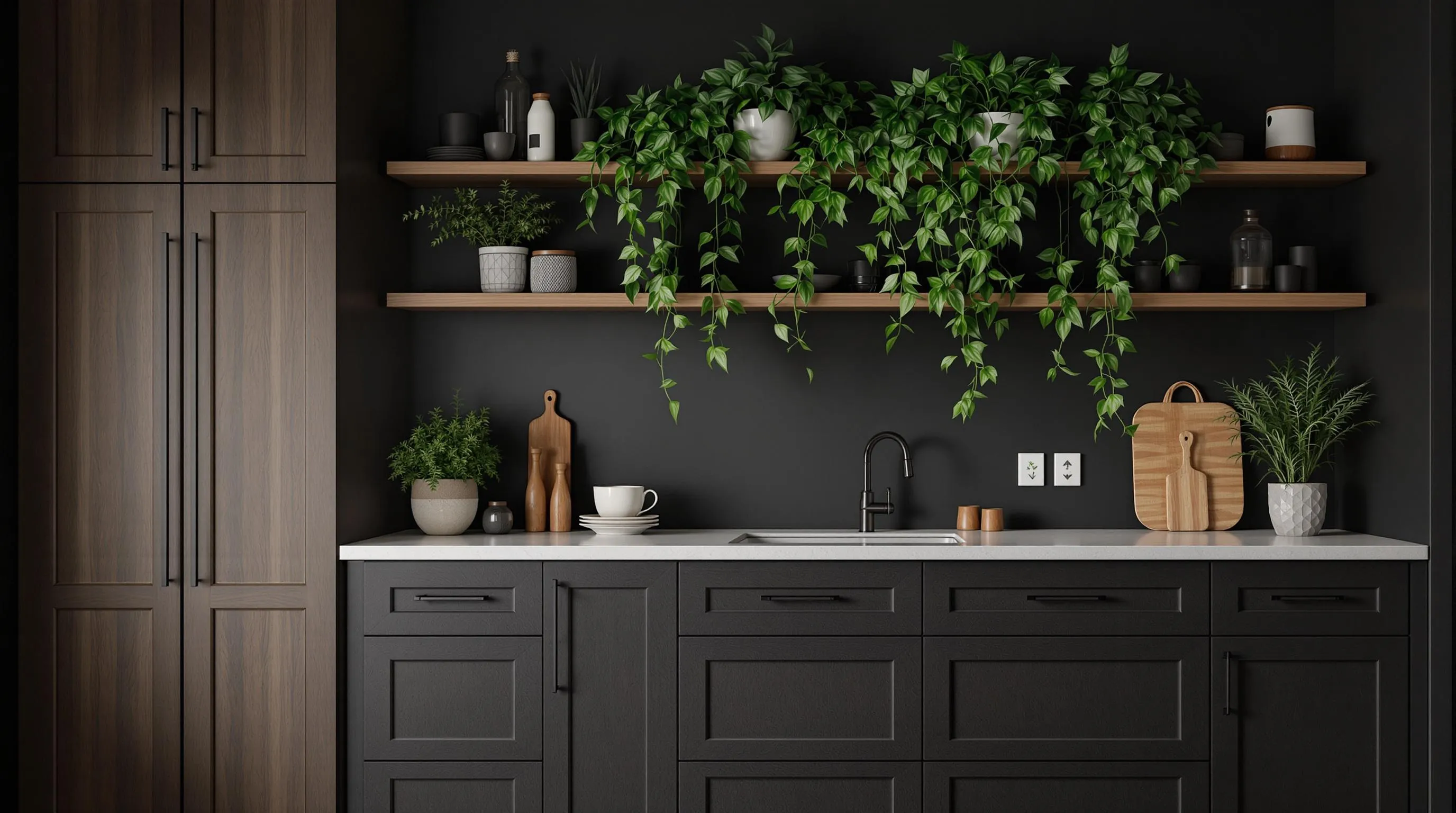
Incorporating natural elements into a moody kitchen design creates the perfect balance between dramatic and inviting. Plants and wood tones can soften the intensity of dark colors while maintaining the sophisticated atmosphere that makes moody kitchens so appealing.
Low-Light Plants That Thrive in Dark Kitchens
Dark kitchens offer the perfect opportunity to showcase plants that naturally flourish in low-light environments. Chinese Evergreen stands out as an excellent choice for moody kitchens, featuring beautiful ornamental leaves that add visual interest without requiring abundant sunlight. Pothos plants bring versatility to darker spaces, with their trailing vines that can drape elegantly from open shelving or high cabinets. Snake Plants (Mother-in-Law’s Tongue) serve dual purposes in moody kitchens by purifying the air while tolerating minimal light conditions. Positioning potted trees or houseplants on open shelving introduces a feel-good element that breathes life into darker color schemes. These resilient plant varieties create a striking contrast against dark backgrounds, effectively softening the overall aesthetic without compromising the kitchen’s moody character.
Natural Wood Tones to Warm Up Dark Spaces
Wood elements provide essential warmth that balances the coolness often present in moody kitchen designs. Dark wood cabinets deliver a rich, sophisticated feel, especially when paired with lighter countertops to create ever-changing visual contrast. Reclaimed wood brings character and vintage charm to contemporary dark kitchens, adding layers of history and texture to the space. Wood flooring contributes important coziness to moody kitchens and can be stained to perfectly complement the desired color palette. The natural grain patterns in wood surfaces create subtle movement within the design, preventing dark spaces from feeling static or flat. Incorporating these wooden elements alongside deep colors and metallic accents results in a sophisticated yet inviting atmosphere that distinguishes truly successful moody kitchen designs.
Budget-Friendly Ways to Achieve a Moody Kitchen Vibe
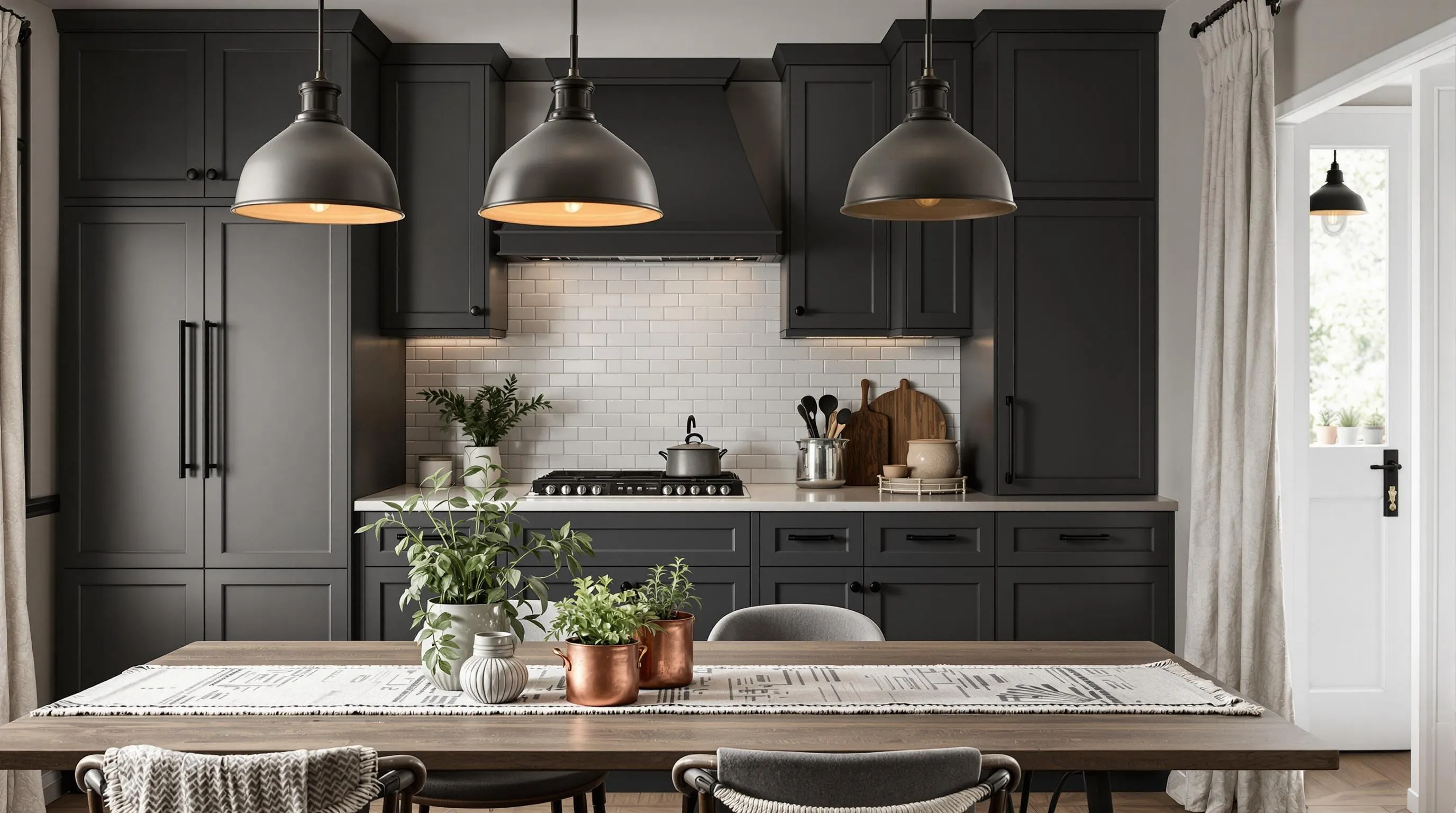
Creating a moody kitchen doesn’t require a complete renovation or expensive overhaul. We’ve gathered some affordable strategies to help you transform your kitchen into a sophisticated, atmospheric space without very costly.
DIY Cabinet Painting Techniques
Painting your cabinets is one of the most cost-effective ways to achieve a dramatic moody kitchen transformation. Proper surface preparation is essential—thoroughly clean your cabinets, sand them lightly to create texture for better adhesion, and apply a quality primer before adding your chosen color. For a professional finish, use a brush for detailed edges and corners while employing a small roller on flat surfaces to prevent unsightly streaks. Dark, moody shades like charcoal, espresso brown, forest green, or navy blue create instant drama and contrast against lighter elements in your kitchen. Matte finishes work particularly well for creating that sophisticated moody aesthetic and are often more forgiving of surface imperfections than glossier options. These deep hues immediately transform the character of your space while costing significantly less than replacing cabinetry.
Small Decor Changes with Big Impact
Hardware swaps offer tremendous visual impact with minimal investment. Installing matte black or brushed brass handles and knobs instantly elevates your kitchen’s sophistication level and complements a moody color palette. Textiles present another budget-friendly opportunity—introduce linen curtains or patterned runner rugs to soften the overall aesthetic and add textural interest to your space. Greenery brings life to dark-toned kitchens; position potted herbs or trailing plants on shelves and countertops to create organic contrast against deeper backgrounds. Layered lighting dramatically transforms the mood; add warm-toned pendant lights or under-cabinet LEDs to balance shadows and highlight architectural features. Thrifted vintage items such as copper pots, framed artwork, or rustic utensils add character and history to your kitchen without the high price tag of new decor. Metallic accents in brushed gold or aged brass finish the look, reflecting light beautifully against darker surfaces and adding necessary warmth to balance the moody atmosphere.
Balancing Function and Mood in Kitchen Design

Creating a moody kitchen requires thoughtful balance between aesthetic appeal and practical functionality. We need to ensure that while embracing darker tones and atmospheric elements, the space remains highly usable and efficient for daily cooking tasks.
Practical Storage Answers for Dark Kitchens
Open shelving and glass-front cabinets serve as excellent storage answers in moody kitchens, effectively breaking up the intensity of dark walls and cabinetry. These features create visual depth while allowing you to display favorite dishware or decorative items that add personality to the space. Incorporating contrasting elements like lighter shelving against dark walls helps prevent the kitchen from feeling too heavy or closed-in. Natural wood floating shelves, for instance, can warm up a dark kitchen while providing accessible storage for frequently used items. Glass-front upper cabinets allow light to penetrate deeper into the space, creating an airier feel even with dark surrounding elements.
Maintaining Workspace Visibility
Multiple light sources are essential in a moody kitchen to ensure adequate visibility for food preparation and cooking tasks. Task lighting above primary work zones, under-cabinet lighting for countertops, and ambient lighting for overall illumination create a functional layered approach. Reflective finishes on appliances and hardware enhance brightness in dark kitchens while adding an elegant touch that complements the sophisticated atmosphere. High-quality stainless steel or polished chrome fixtures can bounce light around the space, improving visibility without compromising the moody aesthetic. Balancing light and dark elements through strategic use of metallics or lighter accents helps maintain the rich, dramatic feel while ensuring the workspace remains practical and visible. Brushed brass or copper hardware, for example, can add warmth and reflectivity against darker cabinet backgrounds, creating functional contrast that enhances both visibility and design appeal.
Modern vs. Traditional Approaches to Moody Kitchens
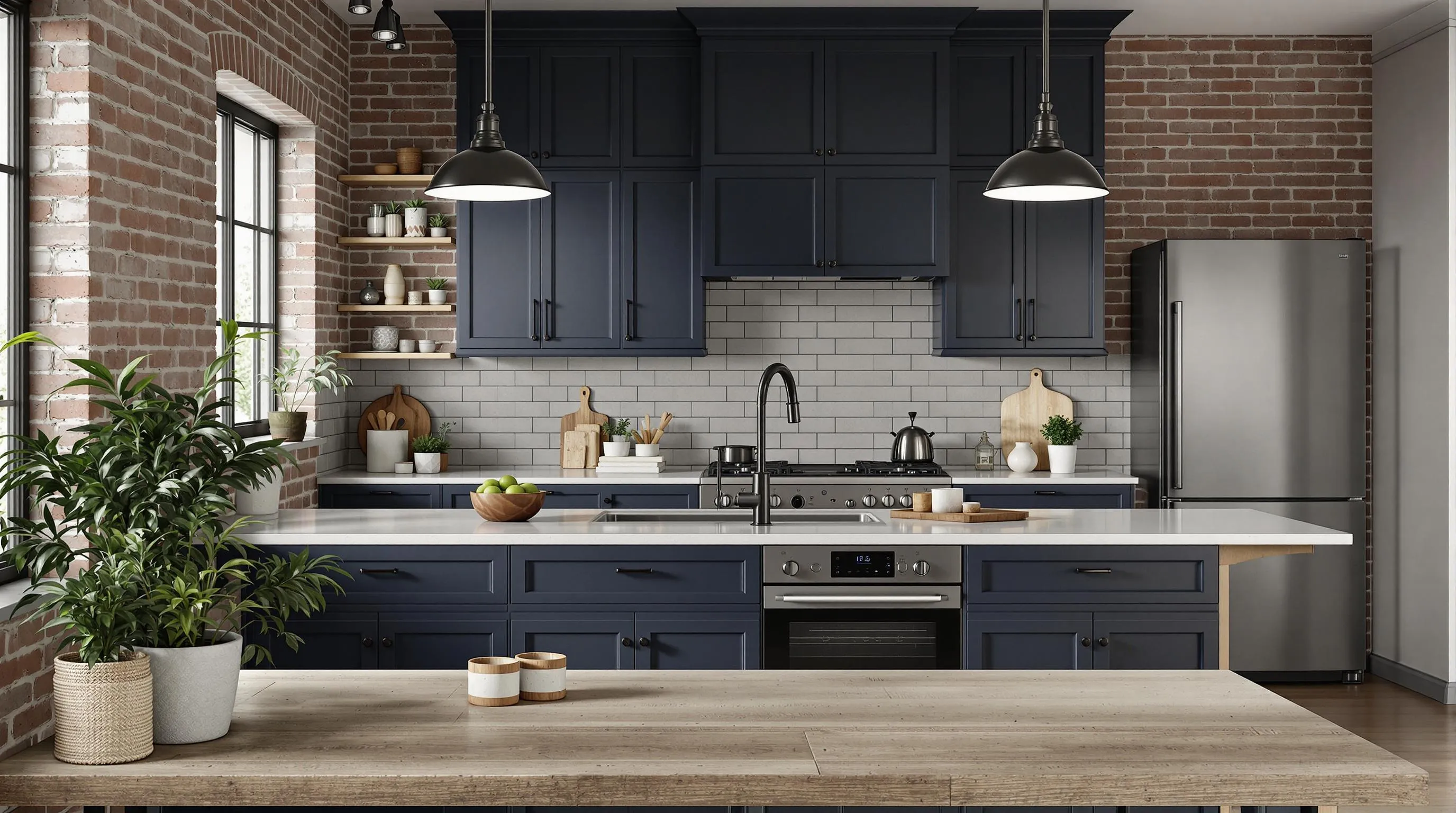
When designing a moody kitchen, you can take either a modern or traditional approach, each offering distinct aesthetics while maintaining that coveted atmospheric vibe. Both styles create sophisticated, cozy spaces that serve as alternatives to conventional bright kitchens.
Modern Moody Kitchen Approaches
Modern moody kitchens embrace sleek, contemporary design elements while incorporating deep, rich colors. Dark appliances serve as focal points in these spaces, complementing deep color schemes like black, gray, forest green, or navy blue. Clean lines and minimalist cabinetry create a streamlined appearance that feels both luxurious and intentional. Stylish pendant lighting fixtures add visual interest while providing necessary illumination, and metallic accents in brass or chrome introduce a touch of glamour against darker backgrounds. Matte finishes on surfaces create depth and dimension, while high-gloss tiles can reflect light to prevent the space from feeling too enclosed.
Traditional Moody Kitchen Approaches
Traditional moody kitchens focus on rich wood tones and reclaimed finishes to establish a warm, inviting atmosphere. Natural materials like oak, walnut, or mahogany cabinetry provide inherent depth and character that modern materials often lack. Textural elements play a crucial role in traditional moody designs, with varied surfaces creating visual interest throughout the space. Incorporating greenery through potted herbs or small plants brings life and organic contrast to these darker spaces. Traditional moody kitchens often feature architectural details like crown molding or raised panel cabinets, adding sophistication and timeless appeal.
Industrial-Inspired Moody Kitchen Ideas
Industrial moody kitchens prominently feature exposed brick walls that add instant texture and urban character. Metal accents like steel shelving, copper hoods, or iron fixtures reinforce the industrial aesthetic while complementing darker color palettes. Industrial lighting with exposed bulbs or factory-inspired fixtures creates both ambiance and authenticity in these spaces. Open shelving constructed from metal and reclaimed wood displays items while maintaining the industrial vibe. Concrete countertops or flooring introduce a raw, unfinished quality that perfectly aligns with both the industrial style and the moody kitchen concept.
Rustic and Farmhouse Dark Kitchen Concepts
Rustic moody kitchens incorporate natural stone elements like granite or slate that add earthiness and organic texture. Wooden beams across ceilings or as decorative accents bring warmth and rustic charm to these darker spaces. Vintage decor pieces such as antique scales, pottery, or signage add character and history to farmhouse-inspired moody kitchens. Textiles like area rugs, linen curtains, or upholstered seating soften the overall look while maintaining the cozy atmosphere. Modern appliances seamlessly blend with traditional farmhouse features when finished in matte black or covered with custom panels, creating a balanced space that feels both authentic and functional.
Maintaining and Cleaning Dark Kitchen Surfaces

Regular Cleaning Routines
Microfiber cloths are essential for cleaning dark matte cabinets without leaving streaks or lint behind. We recommend using these soft cloths with minimal cleaning solution to maintain the integrity of your dark surfaces. Daily wipe-downs prevent buildup of fingerprints and cooking residue that become more visible on dark finishes. Gentle circular motions work best when cleaning matte surfaces to avoid creating a patchy appearance.
Preventing Dust and Fingerprints
Dust particles stand out dramatically against dark kitchen surfaces, requiring more frequent attention than lighter counterparts. We suggest using electrostatic dusters for biweekly maintenance to capture dust before it settles into textured surfaces. Fingerprints show prominently on glossy dark cabinets, so consider placing small hand towels near frequently touched areas. Touch-latch mechanisms or handle-free cabinets can minimize fingerprint issues while maintaining your kitchen’s sleek aesthetic.
Specialized Care for Dark Countertops
Dark quartz or granite countertops hide stains better but require regular sealing to maintain their lustrous appearance. We recommend pH-neutral cleaners for stone surfaces to prevent etching that becomes particularly visible on dark materials. Coffee, wine, and oil spills should be wiped immediately, as they can leave subtle marks that disrupt the uniform appearance of dark countertops. Regular application of appropriate sealants every 6-12 months protects your investment and preserves the rich depth of dark stone surfaces.
Hardware and Fixture Maintenance
Matte black or brass fixtures require non-abrasive cleaners to preserve their sophisticated finish. We advise against harsh chemicals that can strip protective coatings from metallic accents in moody kitchens. Soft cloths dampened with mild soap and water effectively clean most hardware without damaging finishes. Brass elements benefit from periodic polishing with specialized products that enhance their warm glow against dark surroundings.
Lighting Considerations for Easier Maintenance
Under-cabinet LED strips significantly reduce shadow-heavy areas that tend to accentuate dust or smudges. We find that strategically placed pendant lights help illuminate workspaces while maintaining the atmospheric quality of moody kitchens. Proper lighting makes cleaning more efficient by revealing spots that need attention before they become noticeable problems. Dimmable options provide practical illumination for maintenance tasks while preserving the moody ambiance when entertaining.
Managing Plant Displays in Dark Kitchens
Plants create beautiful organic contrast in moody kitchens but can cause water marks on dark surfaces. We suggest placing all greenery on trays or decorative plates to prevent moisture damage to cabinetry and countertops. Choosing planters with built-in drainage systems helps avoid overflow issues that particularly affect dark finishes. Regular inspection of plant areas prevents water damage that can be especially difficult to repair on dark cabinetry.
Flooring Maintenance Strategies
Dark hardwood or tile floors in moody kitchens benefit from frequent sweeping to minimize visible debris. We recommend matte-finish cleaners specifically formulated for dark flooring to avoid streaking or residue. Microfiber mops capture dust more effectively than traditional string mops on dark surfaces. Area rugs in high-traffic zones protect flooring while adding textural interest to your moody kitchen design.
Seasonal Deep Cleaning Tips
Seasonal deep cleaning helps maintain the sophisticated appearance of dark kitchen elements year-round. We advise removing all items from countertops quarterly to address accumulated grime in corners and crevices. Cabinet exteriors benefit from gentle degreasing answers applied with microfiber cloths followed by a clean water wipe. Polishing natural wood elements with appropriate oils restores richness to warm wood tones that complement dark cabinetry in moody kitchen designs.
Conclusion: Embracing the Drama in Your Kitchen Design
Moody kitchens offer a bold departure from conventional design while creating spaces that feel both luxurious and intimate. By thoughtfully balancing dark elements with strategic lighting and rich textures we’ve seen how these designs can transform everyday cooking spaces into sophisticated sanctuaries.
Whether you’re ready for a complete renovation or looking for budget-friendly updates the path to a moody kitchen is accessible for any homeowner. Remember that contrast is key – the interplay between light and dark creates the ever-changing tension that makes these spaces so compelling.
The beauty of moody kitchen design lies in its adaptability across different styles from modern to traditional while maintaining that distinctive atmospheric quality. By embracing this dramatic aesthetic we’re not just creating kitchens we’re crafting experiences that engage the senses and elevate the heart of our homes.
Frequently Asked Questions
What defines a “moody kitchen” in interior design?
A moody kitchen features dark cabinetry, rich color palettes (deep blues, forest greens, charcoal grays), and strategic lighting to create depth and character. Unlike bright white kitchens, these spaces use darker elements to evoke sophistication and intimacy while creating a cocoon-like atmosphere that transforms ordinary cooking routines into meaningful experiences.
What are the best color combinations for a moody kitchen?
Top combinations include deep navy with brass accents, charcoal gray with natural wood, black-on-black with varied textures, emerald green with gold touches, and dark gray with marble accents. Dark wood with metallic highlights also works beautifully. The key is balancing dark tones with lighter elements to maintain a welcoming yet sophisticated atmosphere.
How important is lighting in a moody kitchen design?
Lighting is crucial in moody kitchens. Incorporate layered lighting: statement pendants as focal points, dimmable fixtures for adjustable ambiance, under-cabinet LEDs for task lighting, and ambient sources like candles for depth. This creates a sophisticated interplay that enhances the moody aesthetic while ensuring the space remains functional.
What materials work best in moody kitchen designs?
Matte black fixtures and hardware create cohesion, while veined marble or dark stone countertops add luxury and dimension. Textured backsplashes using high-gloss tiles, rustic stone, or glass enhance depth and prevent monotony. These rich materials maintain the moody ambiance while ensuring the kitchen remains visually interesting and inviting.
Can I create a moody kitchen on a budget?
Absolutely! Paint existing cabinets in dark, moody shades after proper preparation. Swap hardware for matte black or brushed brass options. Add textiles like linen curtains in rich colors and incorporate greenery for organic contrast. Layer lighting with affordable fixtures and introduce thrifted vintage items for character without breaking the bank.
How can I balance aesthetics with functionality in a dark kitchen?
Incorporate open shelving and glass-front cabinets to break up dark elements while providing accessible storage. Ensure multiple light sources for adequate task visibility. Consider reflective finishes on appliances to enhance brightness. Add strategic metallics or lighter accents to maintain drama while keeping the workspace practical.
What are the different style approaches to moody kitchens?
Modern moody kitchens feature sleek lines and minimalist cabinetry, while traditional designs emphasize rich wood tones. Industrial-inspired spaces incorporate exposed brick and metal, and rustic concepts utilize natural stone and vintage elements. All styles create sophisticated, cozy atmospheres with their unique interpretations of the moody aesthetic.
How do I maintain and clean dark kitchen surfaces?
Use microfiber cloths for regular cleaning to prevent streaks and fingerprints. Employ electrostatic dusters for effective dust management. Select pH-neutral cleaners specifically for dark countertops. Ensure proper lighting for maintenance tasks and implement seasonal deep cleaning to preserve the sophisticated appearance of dark elements.
Will a moody kitchen make my space feel too small?
Not necessarily. Strategic lighting, reflective elements like glass or metallic accents, and balanced color combinations prevent a cramped feeling. Consider incorporating lighter elements on upper cabinets or walls while keeping lower cabinets dark. Proper lighting design dramatically affects how spacious a moody kitchen feels.
Are moody kitchens a passing trend or timeless design?
Moody kitchens have staying power beyond trend cycles. Their timeless appeal comes from creating emotionally resonant spaces that balance sophistication with comfort. When executed with quality materials and thoughtful design, dark kitchens offer enduring elegance that transcends fleeting design fads.


